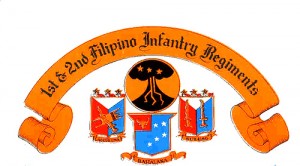
This article was brought to our attention by Guro Hospecio "Bud" Balani, Jr. As it turns out both his father, Hospecio Balbuena Balani, Sr., and his uncle, Martin D. Balbuena, were both members of the Regiment. He also had numerous uncles in the Regiment but to get their names, he'd have to dig deep into the darkest recesses of his mind, and it might get ugly in there. From what he understands, "The United States wanted to be at Regiment strength so they eventually merged the three Battalions into one unit and formed the 1st Filipino Regiment (keeping the First Unit's Patch). Regiments are two or more Battalions, Battalions are three or more Companies. Companies are three or more Platoons. Platoons are three or more Squads. Squads are nine strong. These are just rough estimates. Also, any unit with the spelling of "Philippines" were US Army units that were recruited in the homeland. There were many Philippine Scout units, all in the Philippine islands. Any unit with the spelling of "Filipino", was a unit formed in the United States, with the only units being Laging Una, Sulong and Bahala Na." Saturday, August 14th, 2004 The 1st and 2nd Filipino Infantry Regiments By David T. Vivit, 1LT, AUS (Ret) Laging Una - Sulung The 1st & 2nd (Laging Una - Sulung) Filipino Infantry Regiments were units of the Army of the United States (AUS) inducted into service during World War II. They were wholly manned by Filipino citizens in this country and Hawaii and officered by both Filipinos and Americans, the only non citizen units in the American Citizen Army. They were similar to the Philippine Scouts in that the latter were also wholly manned by Filipino citizens with both Filipino and American officers, but the similarities ended there. The Scouts were professional soldiers in the Philippine Department of the United States Regular Army (USA). Most of the men were married and enjoyed a high economic and social status in the Philippines in contrast to the mostly single discriminated against (in the U.S.) "laborers" and students of the Filipino Regiments. Each group of Filipino soldiers played important but different roles in World War II. After the Japanese sneak attack on Pearl Harbor and Clark Field, Filipinos in the U.S. and Hawaii rushed to Army Recruiting Stations to enlist only to be rejected because they were not (US) citizens (Filipinos were not eligible for U.S. citizenship before the war). As residents, however, they were registered under the Draft Law, and when the first Filipino Battalion was activated in San Luis Obispo, California in April 1942, they "volunteered" for the draft instead of waiting for their call. This unique unit was to spearhead MacArthur's liberation forces when he returned to the Philippines. But the military authorities made a great miscalculation! In three months the 1st Filipino Battalion became the 1st Filipino Regiment, activated in Salinas on July 13, 1942 and on October 14th of the same year the 2nd Regiment was activated at Ft. Ord, bringing together a fighting force of more than 7,000 men. If created earlier, the Battalion very well could have become a Division. By the time it was activated hundreds had already joined the Navy and Army Air Corps. With an average age of over 30, they more than made up this overage by their spirit and enthusiasm. In no other units of the AUS in WWII, including the much publicized 442nd Regimental Combat Team (NISEI), was the motivation greater and the morale higher than in the 1st & 2nd Filipino Regiments. About the end of 1942 and in early 1943, these Filipino soldiers became American citizens under a new U.S Naturalization Law in mass oath taking ceremonies which made headlines throughout the country. After two years of intensive training in California without a single Court Martial case, these units went to New Guinea to prepare for their landings in the Philippines. Here the 2nd Regiment was split up into the Counter-Intelligence Units (CIC), the Alamo Scouts and the Philippine Civil Affairs Unit (PCAU) all of which played important roles during the liberation. The 1st Regiment remained intact as a combat team but for some unknown reason was not with the initial landing forces in Leyte. Instead it was relegated to the minor (but more dangerous against a fanatical enemy) role of mopping-up operations in Samar and Leyte. In accomplishing this difficult mission with minimum casualties, it earned the reputation of being the "most decorated regiment in the Pacific". It remained for a "child" of the regiments, 1st Reconnaissance Battalion (Bahala Na) known only as "commandos" in the Philippines, whose operations during the occupation had been kept secret until recently, to really "spearhead MacArthur's return to the Islands." But this is a story in itself. More significant than their military feats was their accomplishments in the field of romance. These gallant soldiers literally chased the shy, coy and above … [Read more...]
















